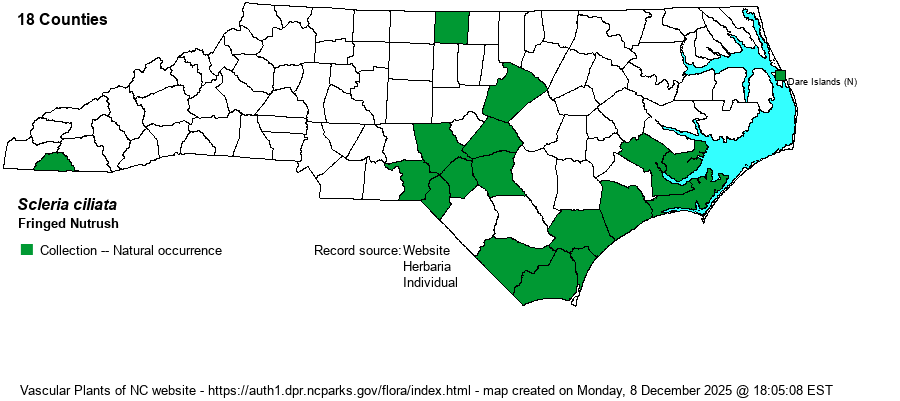| Author | Michaux | |
| Distribution | Scleria ciliata is now understood to include var. ciliata and var. glabra as synonyms. The former S. ciliata var. elliottii, as shown in Weakley (2018), has now been elevated to full species status, as S. elliottii (according to Richard LeBlond and Bruce Sorrie).
Outer Coastal Plain and Sandhills, with gap in between; rare on the Outer Banks (Roanoke Island), Caswell County (northern Piedmont), and Clay County (southern Mountains).
VA to MO, south to FL and TX; Cuba. | |
| Abundance | Uncommon in the outer Coastal Plain and Sandhills; very rare elsewhere and on the Outer Banks. | |
| Habitat | Moist to mesic or dry pine savannas, flatwoods, pine-oak sandhills, usually in sandy soil. Not strictly in wetlands like some other species. | |
| Phenology | Flowering and fruiting May-August. | |
| Identification | As with most other nutrushes, the stems grow in a tight row from a tough horizontal rhizome. The stems reach 1 to nearly 2 feet tall; they and the leaves are smooth to minutely hairy and may be short-ciliate on the margins. Small clusters of spikelets grow terminally and from the leaf axils. It is much like S. elliottii, but that plant has wider leaves, and the leaves and stem are densely covered with ciliate hairs. See also S. bellii. | |
| Taxonomic Comments | Scleria ciliata is now understood to include var. ciliata and var. glabra as synonyms. The former S. ciliata var. elliottii, as shown in Weakley (2018), has now been elevated to full species status, as S. elliottii (according to B. Sorrie, one of the website editors). A synonym is S. brittonii.
The genus Scleria, named as nutrushes, is a group of sedges notable for the white, often glossy, achenes (seeds) and tough, knotty, horizontal rhizomes (absent in S. verticillata, S. muehlenbergii, and S. reticularis). Stems are 1-many per plant, terminated by inflorescences of 1-several spikelets, subtended by leafy bracts. In some species there are also inflorescences produced from upper and middle stem leaf axils, these usually on long arching stalks. A dissecting scope is necessary to examine the achene for shape, ornamentation (bumps, pits, ridges), and hairs. Just as important are features of the hypogonium, upon which the achene tightly sits: present or not, how many lobes, and ornamentation (bumps, sharp points, etc.). | |
| Other Common Name(s) | Hairy Nutrush | |
| State Rank | S3 [S3S4] | |
| Global Rank | G5 | |
| State Status | | |
| US Status | | |
| USACE-agcp | FAC link |
| USACE-emp | FAC link |

